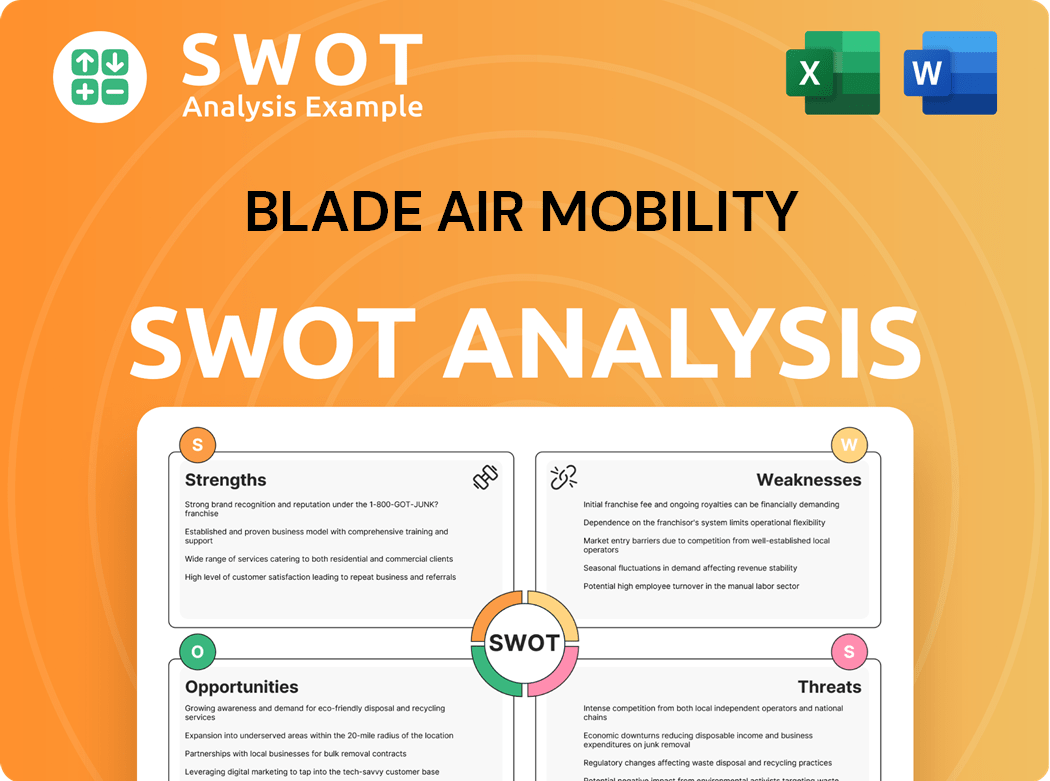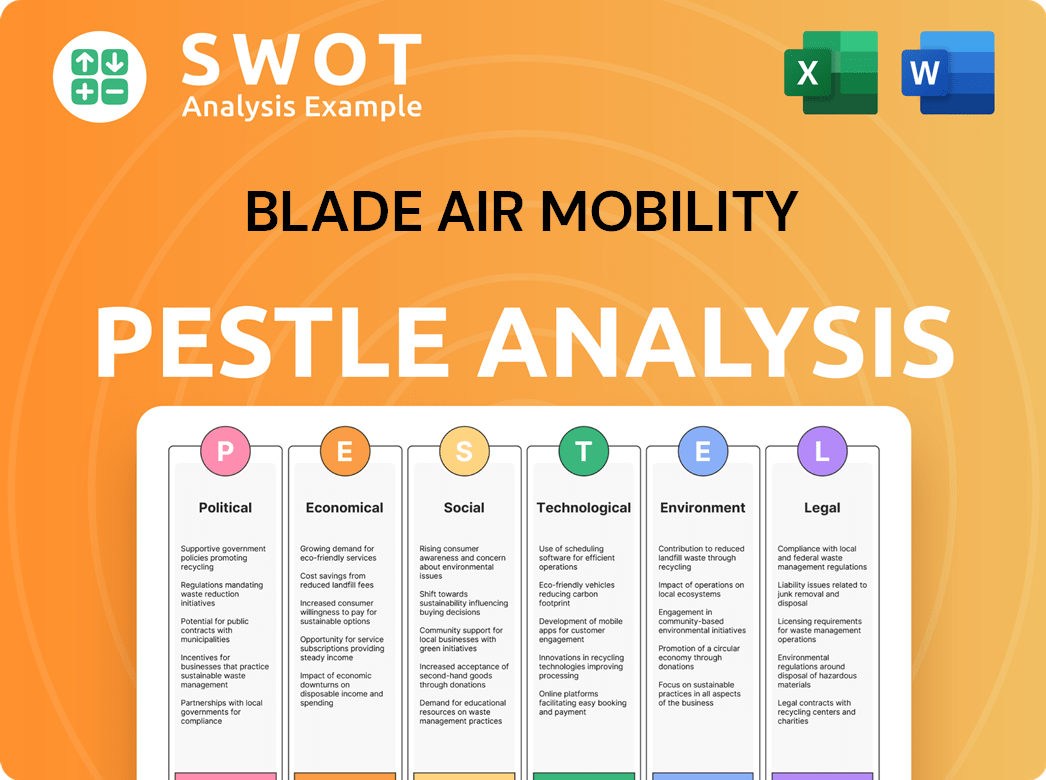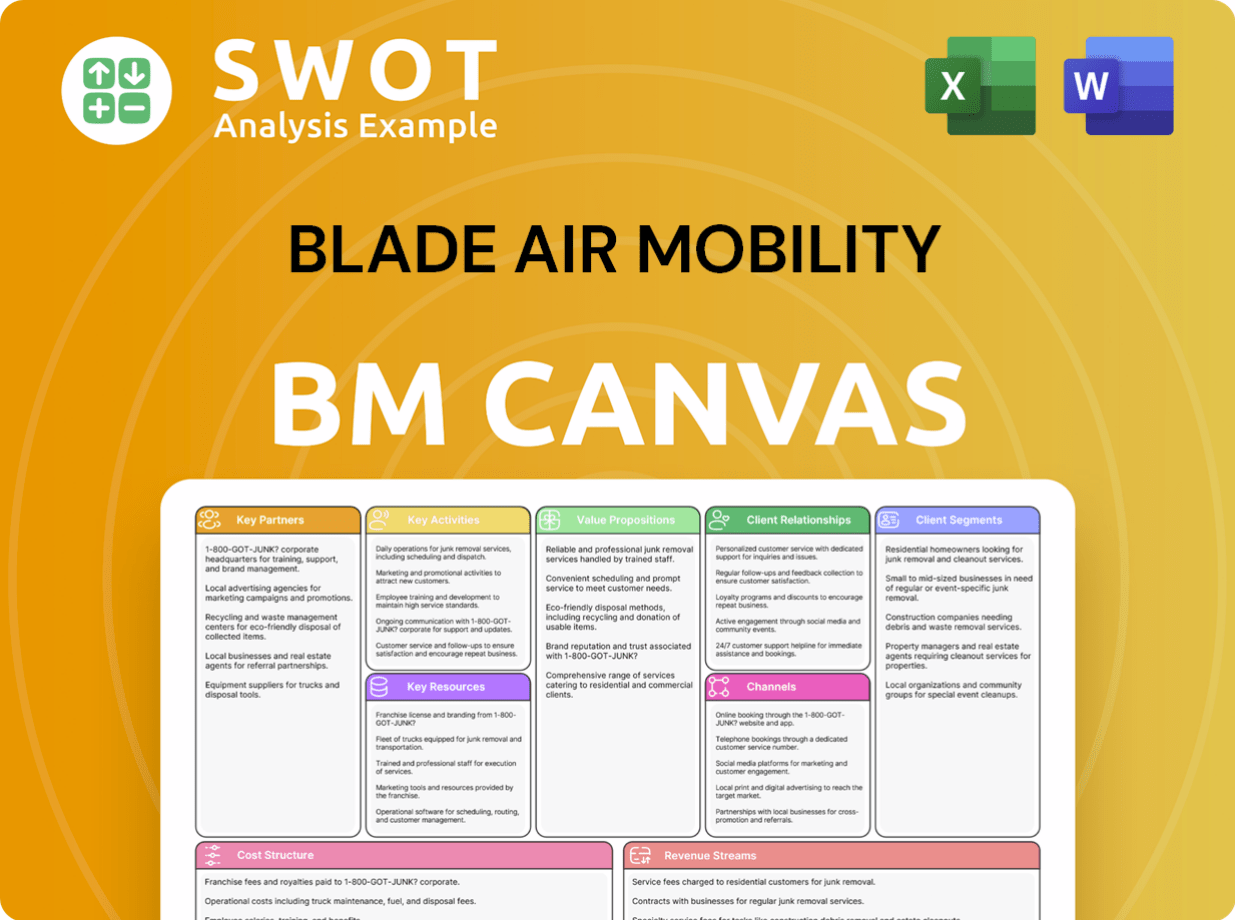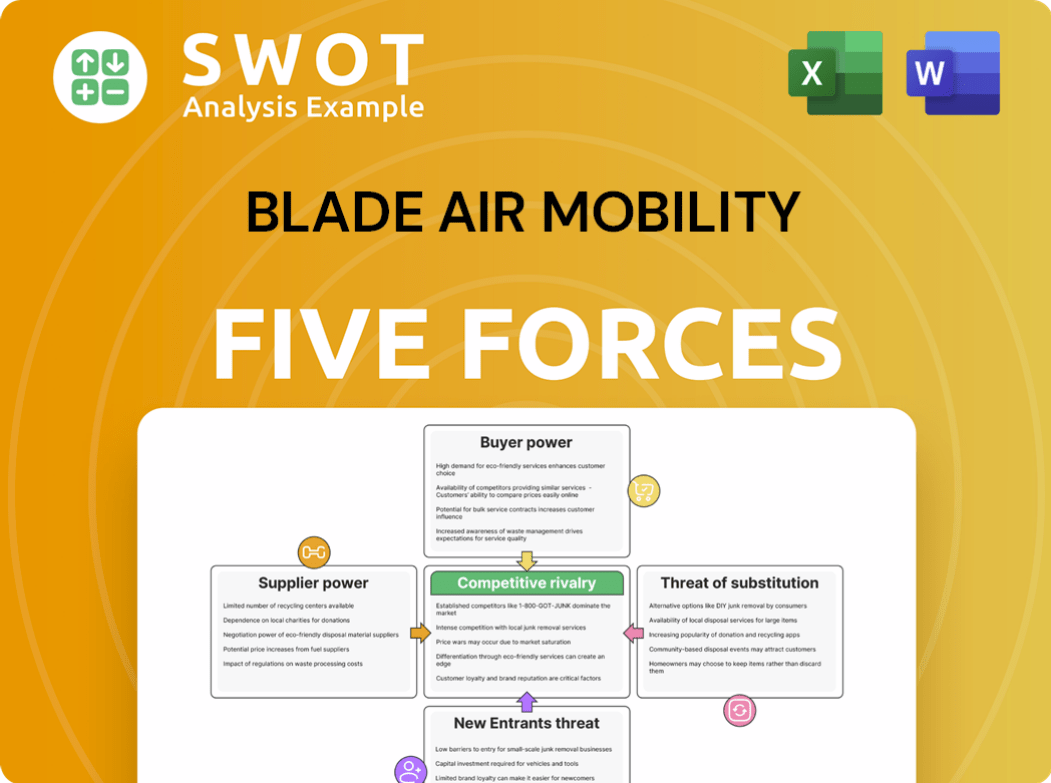Blade Air Mobility Bundle
Who Flies with Blade Air Mobility?
Understanding the Blade Air Mobility SWOT Analysis is crucial, but even more critical is knowing who exactly is using their services. As the urban air mobility landscape rapidly evolves, Blade Air Mobility's success hinges on a deep understanding of its customer demographics and target market. This analysis delves into the profile of Blade Air Mobility customers, their needs, and how the company adapts to serve them in a changing market.

From luxury travelers to critical medical transport, Blade Air Mobility has cultivated a diverse user base. Exploring the Blade Air Mobility user profile reveals insights into air taxi customers and their preferences. As urban air mobility expands, understanding the evolution of Blade Air Mobility's target market and its customer segmentation strategies becomes increasingly important for investors and strategists alike.
Who Are Blade Air Mobility’s Main Customers?
Understanding the customer demographics and target market of Blade Air Mobility is crucial for grasping its business model. The company primarily focuses on two key segments: consumers (B2C) and businesses (B2B). This dual approach allows it to cater to a diverse clientele, each with specific needs and preferences within the urban air mobility sector.
The Passenger segment targets high-net-worth individuals seeking efficient travel solutions, while the Medical segment serves hospitals and transplant centers. This segmentation strategy enables Blade Air Mobility to optimize its services and tailor its marketing efforts to reach the most relevant customer profiles. The company's success hinges on its ability to effectively serve both these distinct groups.
Blade Air Mobility's services are designed to meet the needs of its diverse clientele. The Passenger segment benefits from time-saving travel options, while the Medical segment relies on the company's services for critical organ transport. This customer-centric approach is a key factor in the company's growth and market position. The company's focus on customer satisfaction is evident in its strategic decisions and operational efficiency.
The Passenger segment of Blade Air Mobility, which caters to individuals seeking efficient travel, experienced a significant year-over-year growth of 42.0% excluding Canada in Q1 2025. This segment primarily serves affluent customers who prioritize time savings and convenience. The 'Short Distance' product line, encompassing helicopter and seaplane flights, operates routes between 10 and 100 miles in the United States and Europe.
The Medical segment, known as MediMobility Organ Transport, is a significant revenue driver, accounting for approximately 60% of revenue in the past year. This B2B segment focuses on transporting human organs for transplant and medical teams. The Medical segment generated $150 million with a 13% EBITDA margin. The growth in this segment is driven by the increasing volume and distance of organ transplants in the U.S.
Blade Air Mobility's total revenue in Q1 2025 increased by 5.4% to $54.3 million, compared to $51.5 million in the prior year period. Excluding Canada, revenue increased by 10.9% year-over-year. For the full year 2024, Blade reported total revenue of $248.7 million, a 10.4% increase from $225.2 million in 2023. The company is forecasting revenue of $245-265 million for the full year 2025.
The acquisition of Trinity Air Medical in September 2021 was a strategic move, with the combined Medical segment growing to approximately $142 million in trailing twelve-month revenue as of September 2024. Blade owned nine aircraft for its Medical segment at the end of December 2024, with a tenth entering service in February 2025. The company expects its owned fleet to represent approximately one-third of its Medical flight hours in 2025.
While specific demographic breakdowns are not publicly detailed, the Passenger segment likely includes high-income professionals and leisure travelers. The Medical segment serves hospitals and transplant centers, highlighting the diverse nature of Blade Air Mobility's customer base. The company's services cater to different needs, with the Passenger segment focusing on convenience and the Medical segment on critical medical transport. For more on the company's history, read Brief History of Blade Air Mobility.
- Customer demographics vary between segments.
- The Blade Air Mobility target market includes high-net-worth individuals and medical institutions.
- Air taxi customers are primarily in the Passenger segment.
- The Blade Air Mobility user profile is diverse, reflecting the range of services.
Blade Air Mobility SWOT Analysis
- Complete SWOT Breakdown
- Fully Customizable
- Editable in Excel & Word
- Professional Formatting
- Investor-Ready Format

What Do Blade Air Mobility’s Customers Want?
Understanding the customer needs and preferences is crucial for the success of any business. For Blade Air Mobility, this involves catering to distinct requirements within its Passenger and Medical segments. This analysis helps define the Blade Air Mobility target market and informs strategies for customer acquisition and retention.
The Passenger segment focuses on convenience, time efficiency, and a premium experience. Medical segment prioritizes speed, reliability, and precision. These core needs drive the services offered by Blade Air Mobility, shaping its operational strategies and future developments.
The company's approach to meeting these needs is reflected in its service offerings and strategic initiatives, such as the planned transition to Electric Vertical Aircraft (EVA) and enhancements in the Medical segment. This customer-centric focus is essential for growth and market leadership.
The primary drivers for air taxi customers in the Passenger segment are convenience and time savings. Customers value bypassing ground congestion, especially in metropolitan areas. The desire for a seamless, stress-free travel experience is also a significant factor.
Blade addresses the pain point of protracted ground travel through its mobile application. This allows for easy bookings and on-demand charters. The move to EVA aims to reduce noise and environmental impact, broadening the appeal.
In the Medical segment, speed, reliability, and precision are paramount. The time-critical nature of organ transport and medical team transfers demands a highly efficient service. The need for rapid transport is a key unmet need.
Blade's 'asset-light' model and the acquisition of fixed-wing aircraft in 2024 aim to improve economies of scale and service reliability. The 'Trinity Organ Placement Services (TOPS),' launched at the end of 2023, enhances offerings.
Increasing the dedicated fleet and positioning aircraft closer to customers aims to reduce costs and shorten call-out times. Medical trip volumes reached a new monthly record in April 2025, driven by new customer acquisitions.
Blade focuses on customer satisfaction through tailored services and strategic initiatives. The company's approach to understanding and meeting customer needs is central to its growth strategy.
Analyzing customer demographics and travel patterns provides insights into Blade Air Mobility's user profile. This helps in refining services and targeting marketing efforts. The company's strategies are designed to meet the specific needs of its diverse customer base.
- Passenger Segment: Primarily serves high-net-worth individuals who prioritize time and convenience.
- Medical Segment: Serves hospitals, transplant centers, and medical teams requiring urgent transport services.
- Customer Location Analysis: Focuses on major metropolitan areas and regions with high demand for rapid transport.
- Customer Travel Patterns: Varies from leisure travel to critical medical transport, requiring flexible and reliable services.
Blade Air Mobility PESTLE Analysis
- Covers All 6 PESTLE Categories
- No Research Needed – Save Hours of Work
- Built by Experts, Trusted by Consultants
- Instant Download, Ready to Use
- 100% Editable, Fully Customizable

Where does Blade Air Mobility operate?
The geographical market presence of Blade Air Mobility is primarily focused on areas with high ground congestion, specifically in the Northeast United States and Southern Europe. This strategic concentration allows the company to offer urban air mobility solutions, providing significant time savings and convenience to its customers. Expansion and strategic partnerships are key components of their market strategy.
In the United States, Blade's core markets include New York City, with routes to the Hamptons and area airports like JFK, LaGuardia, and Newark. The company also has a presence in Los Angeles and Miami. In Q1 2025, a new service was launched between the Downtown Manhattan Heliport and JFK Airport in partnership with Skyports Infrastructure, further solidifying its presence in the New York market.
Blade has expanded its European footprint through acquisitions and strategic partnerships. This expansion includes Southern France, Monaco, Italy, and Switzerland, where it holds a leading market share. The company has also launched new codeshare agreements, such as with Emirates to and from Monaco, and opened new terminals at Nice Airport. These moves demonstrate Blade's commitment to tailoring its offerings to succeed in diverse markets.
Blade's primary markets are in the Northeast United States, including New York City, and Southern Europe. These locations are chosen for their high population density and significant ground traffic.
Blade has expanded its market reach in Southern Europe through acquisitions and partnerships. This includes Southern France, Monaco, Italy, and Switzerland, where it holds a leading market share.
In Q1 2025, Blade's revenue, excluding Canada, increased by 10.9% year-over-year. Short Distance revenue, excluding Canada, increased 28.1% year-over-year, primarily driven by growth in Europe.
Blade exited its operations in Canada in August 2024, contributing to improved profitability. This strategic decision allowed the company to focus on more profitable markets.
Blade's approach to localization involves tailoring its offerings and partnerships to succeed in diverse markets. For instance, strategic investments in owned aircraft in the Medical segment aim to improve operational and financial performance. The company's geographic distribution of sales indicates a strong focus on high-demand corridors where its urban air mobility solutions offer a significant advantage. To learn more about how Blade Air Mobility approaches its overall business strategy, consider reading about the Marketing Strategy of Blade Air Mobility.
Blade Air Mobility Business Model Canvas
- Complete 9-Block Business Model Canvas
- Effortlessly Communicate Your Business Strategy
- Investor-Ready BMC Format
- 100% Editable and Customizable
- Clear and Structured Layout

How Does Blade Air Mobility Win & Keep Customers?
Customer acquisition and retention strategies are critical for the success of any air mobility service, and for Blade Air Mobility, this is no exception. The company has developed distinct approaches for its Passenger and Medical segments, adapting its strategies to suit the unique needs and characteristics of each customer base. These strategies encompass digital and traditional marketing, strategic partnerships, and a strong focus on customer experience to foster loyalty and drive growth.
For the Passenger segment, Blade initially gained traction through its user-friendly mobile app, which facilitated by-the-seat bookings and expanded the market to include first-time fliers. The company has also invested in flier acquisition campaigns and the launch of new routes to attract new customers. Brand partnerships and collaborations, such as the past partnership with Uber for 'UberChopper,' have also played a role in gaining customers. Blade's brand recognition, especially in its core New York market, is a key factor in attracting customers. Competitors Landscape of Blade Air Mobility also shows how the company positions itself in the market.
In the Medical segment, the focus is on reliability and efficiency. Blade actively seeks new hospital and transplant center clients, which is evident in the launch of new hospital customers in April 2025, contributing to a record month for medical trip volumes. Retention in this segment is built on trust, efficiency, and the ability to meet urgent logistical demands. Blade's strategic adjustments reflect its pivot toward profitability and efficiency, focusing on strategic acquisitions in the Medical segment and investments in additional aircraft and vehicles to drive growth and improve margins.
Blade utilizes its mobile app for convenient bookings. They invest in flier acquisition campaigns and launch new routes. Partnerships like the 'UberChopper' collaboration have also helped with customer acquisition.
The premium nature of the service, coupled with time savings and convenience, fosters loyalty. Blade focuses on customer experience, from booking to flight and after-sales service. The asset-light model offers flexibility to meet customer demand.
Blade actively seeks new hospital and transplant center clients. The launch of new hospital customers in April 2025 contributed to a record month for medical trip volumes. Reliability and efficiency are key drivers for acquisition.
Retention is built on trust, efficiency, and the ability to meet urgent logistical demands. Blade's investment in dedicated aircraft for its Medical segment aims to improve service reliability. Expansion of the 'TOPS' offering deepens integration with medical clients.
Blade's Air taxi customers are typically affluent individuals and business travelers. The Blade Air Mobility target market includes those seeking convenience, time savings, and a premium travel experience. The company's focus is on providing efficient and reliable transport solutions.
Blade operates in urban environments, providing Urban air mobility solutions. The company's services cater to the needs of busy professionals. The focus is on connecting key locations within cities and surrounding areas.
The Blade Air Mobility user profile is defined by a need for speed and convenience. Users value time and appreciate a premium service. The company aims to meet the demands of this specific demographic.
Blade exited certain Passenger routes that did not meet its return thresholds. The company discontinued by-the-seat jet flights between New York and South Florida in November 2023. They exited Canadian operations in August 2024 to improve profitability.
The Passenger segment achieved its first Adjusted EBITDA profitable Q1 since going public. Blade is focusing on strategic acquisitions in the Medical segment. They expect to generate positive free cash flow before aircraft acquisitions.
Blade is investing in additional aircraft and vehicles to drive growth and improve margins. The company aims for long-term sustainability and customer lifetime value. The focus is on expanding service offerings and improving efficiency.
Blade Air Mobility Porter's Five Forces Analysis
- Covers All 5 Competitive Forces in Detail
- Structured for Consultants, Students, and Founders
- 100% Editable in Microsoft Word & Excel
- Instant Digital Download – Use Immediately
- Compatible with Mac & PC – Fully Unlocked

Related Blogs
- What are Mission Vision & Core Values of Blade Air Mobility Company?
- What is Competitive Landscape of Blade Air Mobility Company?
- What is Growth Strategy and Future Prospects of Blade Air Mobility Company?
- How Does Blade Air Mobility Company Work?
- What is Sales and Marketing Strategy of Blade Air Mobility Company?
- What is Brief History of Blade Air Mobility Company?
- Who Owns Blade Air Mobility Company?
Disclaimer
All information, articles, and product details provided on this website are for general informational and educational purposes only. We do not claim any ownership over, nor do we intend to infringe upon, any trademarks, copyrights, logos, brand names, or other intellectual property mentioned or depicted on this site. Such intellectual property remains the property of its respective owners, and any references here are made solely for identification or informational purposes, without implying any affiliation, endorsement, or partnership.
We make no representations or warranties, express or implied, regarding the accuracy, completeness, or suitability of any content or products presented. Nothing on this website should be construed as legal, tax, investment, financial, medical, or other professional advice. In addition, no part of this site—including articles or product references—constitutes a solicitation, recommendation, endorsement, advertisement, or offer to buy or sell any securities, franchises, or other financial instruments, particularly in jurisdictions where such activity would be unlawful.
All content is of a general nature and may not address the specific circumstances of any individual or entity. It is not a substitute for professional advice or services. Any actions you take based on the information provided here are strictly at your own risk. You accept full responsibility for any decisions or outcomes arising from your use of this website and agree to release us from any liability in connection with your use of, or reliance upon, the content or products found herein.